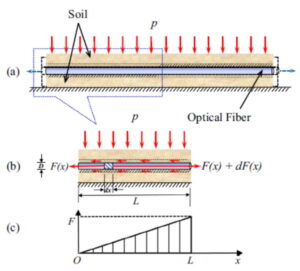作者:朱鸿鹄,佘俊宽,张诚成,施斌
单位:南京大学地球科学与工程学院
摘要:过去几年中,分布式光纤传感系统在监测民用基础设施方面发挥了越来越重要的作用。它们在地质监测应用中的主要挑战之一是提高应变传感光纤在测量周围土体变形时的可靠性。本文提出了一种拉拔试验方法,用于表征光纤与土体之间的变形耦合性。对三种埋入砂土中的光纤进行了一系列拉拔试验,以研究光纤-砂土界面性能。基于试验结果,提出了一个简化的三线性拉拔力-位移关系,以描述光纤-砂土界面的力学行为。三种光纤在光纤-砂土相互作用机制方面的性能差异,可通过有效拔出位移与直径比、残余拔出位移与直径比、峰值和残余剪切强度比等参数来评估。三种光纤的所有四个参数均发现与施加的围压大致呈线性关系,这表明光纤-砂土界面的变形耦合性完全取决于围压。对于所有三种光纤,第一剪切刚度系数约为8 N/mm,残余与峰值剪切强度比约为0.5。此外,使用Mohr-Coulomb破坏准则来获取三种光纤-砂土界面的内聚力和摩擦角。通过对拉拔性能的比较,发现三种光纤中的一种更适合于室内规模的土体变形测量。这些结论可以为预测光纤-土体界面行为和评估应变监测数据的可靠性提供有价值的参考。

Experimental study on pullout performance of sensing optical fibers in compacted sand
Hong-Hu Zhu a,b,c, Jun-Kuan She a,1, Cheng-Cheng Zhang a,1, Bin Shi a,2
a School of Earth Sciences and Engineering, Nanjing University, Nanjing 210023, China
b Department of Engineering, University of Cambridge, Cambridge CB2 1PZ, United Kingdom
c State Key Laboratory of Hydraulics and Mountain River Engineering, Sichuan University, Chengdu 610065, China
Abstract: The distributed optical fiber sensing systems have played an increasingly important role in
monitoring civil infrastructures over the past few years. One of the main challenges of their
applications to geotechnical monitoring is to increase the reliability of strain sensing optical
fibers in measuring the deformation of surrounding soil masses. In this paper, a pullout
test method is proposed to characterize the deformation compatibility between an optical
fiber and soil. A series of pullout tests on three types of sand-embedded optical fibers are
conducted to investigate the performance of the fiber–sand interface. Based on the test
results, an explicit tri-linear pullout force–displacement relationship is proposed to
describe the mechanical behavior of the fiber–sand interface. The performance of the three
fibers regarding fiber–sand interaction mechanism is evaluated in terms of ratio of effective
pullout displacement to diameter, ratio of residual pullout displacement to diameter,
peak shear strength and residual shear strength. All four parameters of the three fibers are
found to have approximately linear relationships with the applied confining pressure,
which reveals that the deformation compatibility of the fiber–sand interface is utterly
dependent on the confining pressure. For all the three fibers, the first shear stiffness coefficient
is about 8 N/mm and the ratio of residual to peak shear strength is about 0.5.
Furthermore, the Mohr–Coulomb failure criterion is used to get the cohesions and friction
angles of the three fiber–sand interfaces. Through a comparison of the pullout performance,
one out of three types of fibers tested is found to be more preferable for soil deformation
measurement in laboratory-scale tests. The conclusions can provide valuable
references for predicting the fiber–soil interface behavior and evaluating the reliability of
strain monitoring data.
Keywords: Distributed geotechnical monitoring; Optical fiber sensor; Optical fiber–soil interface; Pullout test; Confining pressure
